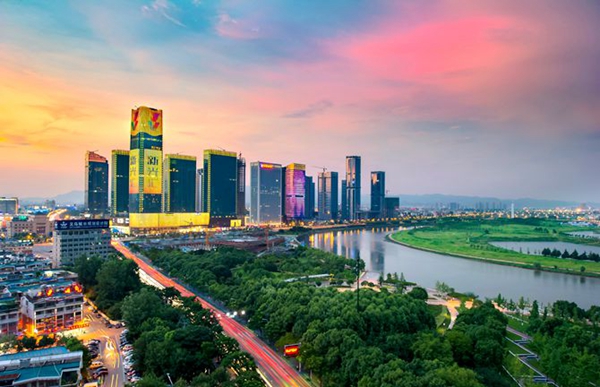This is Jinhua

Yiwu in Jinhua, Zhejiang province [Photo/yiwuzhejiang.chinadaily.com.cn]
Population: 5,604,000 permanent residents (2018)
Population: central part of East China's Zhejiang province, bordering Taizhou to the east, Lishui to the south, Quzhou to the west, and Shaoxing and Hangzhou to the north.
Area: 10,942 square kilometers
Economy:
Jinhua achieved steady economic growth in 2018. Its overall economic operation was steady and progressive, the replacement of old growth drivers was accelerated, and people's livelihoods were improved.
In 2018, Jinhua recorded a GDP of 410.02 billion yuan ($ 59.49 billion), 5.5 percent higher than that of the previous year. The added value of its primary industries was 13.59 billion yuan, up by 1.2 percent; that of secondary industries was 174.55 billion yuan, rising by 5.9 percent and the added value of tertiary industries reached 221.89 billion yuan, an increase of 5.4 percent. The ratio of the three industries was 3.3:42.6:54.1. The per capita GDP in 2018 was 73,428 yuan, up by 4.7 percent.
Administrative divisions:
Under the jurisdiction of the city of Jinhua are two urban districts, namely Wucheng and Jindong, four county-level cities of Lanxi, Yiwu, Dongyang and Yongkang, and three counties, Wuyi, Pujiang and Pan'an. Together they enclose a total of 76 towns, 36 townships, 40 sub-districts, 310 neighborhood communities and 4,438 administrative villages (2017).
Brief introduction:
Jinhua, known as Wuzhou in ancient times, got its name as the "place where the Jinxing (Venus) and the Wunu (four stars in the constellation Aquarius) compete for splendor". It has more than 1,800 years of history and brilliant civilization.
Known as "home to crafts", Jinhua enjoys an advanced civilian-owned economy, with its industry mainly supported by processing and manufacturing. Leading industries of the city include clothing and textiles, mechanics and electronics, pharmaceuticals and chemistry, manufacturing crafts, metalwork processing, architecture and building materials, automobile-and-motorcycle accessories, food processing and plastic ware.
Industries are distributed with different characteristics in different counties or county-level cities. For instance, Yiwu is characterized by its light-industry commodities, Yongkang by its automobile-and-motorcycle accessories and mechanical and electric tools, Dongyang by its clothing, architecture and magnetic materials, Lanxi by its non-ferrous metal, cement, towels and daily chemicals, and Pujiang by its textiles, lock making and crystal lantern ornaments.
As a famous scenic area in East China, Jinhua boasts a long history, beautiful land, and a lot of places of historic interest, so much so that it is known as a "City of Cultural Relics". With arboreal acreage above 60 percent, it is honored as one of the greenest cities in the province and one of the top tourist cities in the country.
